光伏产业是中国实现“双碳”目标的能源转型战略关键产业。过去,光伏市场主要在“五大六小”发电集团持有并主导的集中式大电站开发与农村户用光伏电站建设。
2022年工商业光伏新增装机并网量从2021年的8GW爆发式增长至2022年的25GW (若考虑12月疫情放开导致并网高峰期停工,实际市场潜力接近30GW),主要驱动因素包括电价成本提升、能耗双控影响、业主装机意识增强和三方资本入局。当前工商业光伏的主要场景在经营持续性更稳定、资产风险较低的大型工商业。
展望未来,小微工商业有望在2-3年内突破拐点、成为市场的新增长引擎;而中长期市场需求将结构性向光伏建筑一体化 (BIPV)转变,驱动行业价值与利润水平长足提升
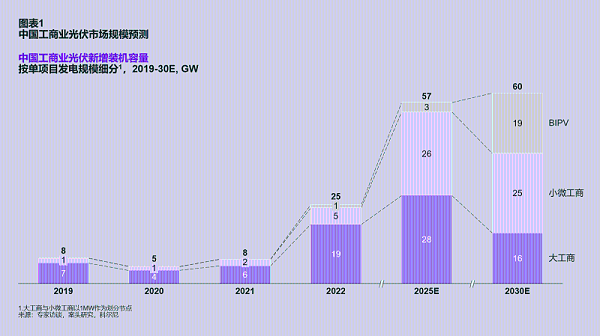
工商业光伏电站市场的参与方主要包括业主方、开发方、持有方、工程方四类 (如图表2),各自承担不同角色:业主方是厂房使用人和用电方(全额上网情况除外);开发方起着业主、资本方、工程方之间的桥梁作用,与持有方、工程方普遍存在交集;持有方是电站资产实际持有单位,可获取发电收益;工程方是光伏电站实际施工建设单位,包含纯工程队与EPC总包单位两类。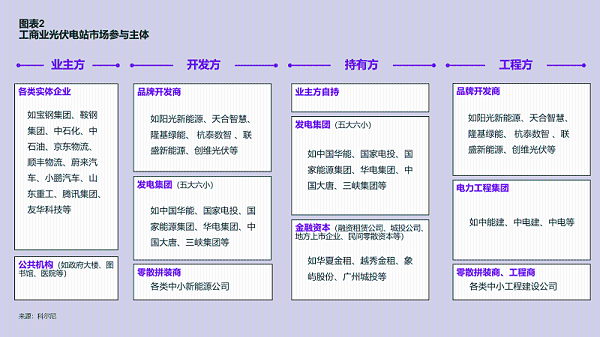
大工商业光伏指单项目发电规模1MW以上的光伏电站项目,在发电集团大规模入场持有与业主装机意愿提升双重推动下,其年装机量从2021年的6GW激增至2022年的19GW,成为2022年工商业光伏爆发的主要驱动力。科尔尼认为,大工商业光伏未来2-3年装机量仍有增长空间,中长期随着装机趋于饱和及新建房屋BIPV渗透率提升,大工商业传统光伏装机量将逐步回落。
大工商业光伏根据电站资产持有方不同,可分为四大模式(如图表3)。总体而言,“五大六小”发电集团持有模式占据市场主导性地位,但随着光伏经济性与安全性逐步经历市场考验,未来业主自持与地方资本持有模式占比将持续上升。
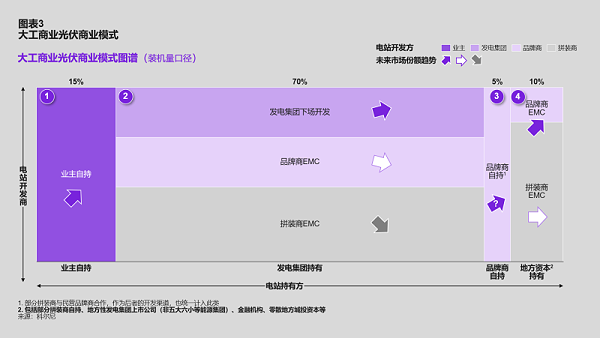
1、业主自持模式:工商业主自主投资并持有电站资产,可获取最高的理论收益。从电站建设方来看,小部分为业主自建, 多数业主采用EPC外包模式进行电站建设。考虑大工商业主对安全性与品质的诉求,未来民营品牌开发商占比将进一步提升。
2、发电集团持有模式:目前发电集团持有资产占大工商业整体的约70%。发电集团可以自主开发, 或者收购民营品牌开发商或拼装商开发的成熟项目。当前发电集团自主开发趋势显著,其凭借低投资回报率红线提供较高的电价折扣,客观上挤压民营品牌商与拼装商生存空间。
3、民营品牌商自持模式:部分民营品牌商选择自持少量高收益率工商业项目,但由于资金规模有限,自持模式在整体市场占比较小(<5%)。目前国家正在试点REITs(房地产信托投资基金),如若放开,未来民营品牌商有望通过发放REITs融资持有光伏资产,从而大幅扩张持有规模、驱动市场变革。
4、地方资本持有模式:通常由品牌商或拼装商负责业主开发和EPC建设,并一体化打包给以城投公司、金融租赁机构为首的地方零散资本进行电站持有。目前光伏的经济回报、安全性已逐步历经市场验证;叠加经济环境不景气,地方资本逐步将光伏视为具有稳定收益率的理财产品,未来该模式的市场影响力将获得长足增长。
当前大工商业市场开发激烈,已步入精细化竞争阶段,未来发展的关键在于把光伏作为减碳重要组成部分,围绕各个行业形成对应的定制化解决方案。首先需要基于行业吸引力和能力适配度对目标行业进行筛选:一方面,从行业整体发展趋势、用电特征、减碳目标、综合能源需求、收益率等维度研判行业吸引力;另一方面,根据企业自身的方案能力、产品能力、服务能力等判断最适合的目标行业。
企业需要为目标行业客户提供覆盖技术和商业两方面的定制化解决方案。具体来说,如何根据客户需求特点,提供针对性的含光伏、储能、融资、电力交易、咨询等综合性的解决方案,达到推动企业减排、保证充分回报、保障生产运营等目标。
单项目发电规模1MW以下的小微工商业市场受需求高度分散、资产风险性高的制约因素影响,尚处于发展早期阶段。其下游应用广泛,物流园区、工业产业园区、散点工厂、商业地产是等均是其下游客户
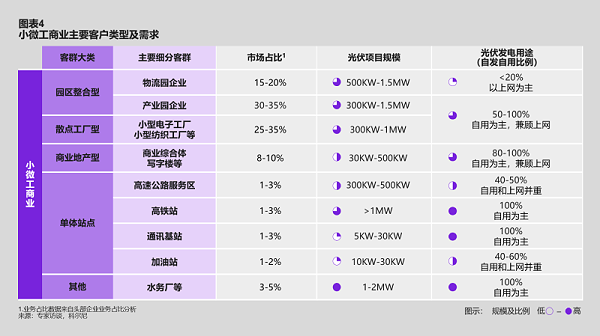
科尔尼认为,随着发电集团外包民营品牌开发商(如阳光新能源、天合智慧等)进行资产打包开发成为趋势,同时工商业主对安全质量的高诉求需要通过品牌口碑、项目经验、与上市公司资质兜底来进行保证,小微工商业的品牌化时代即将来临
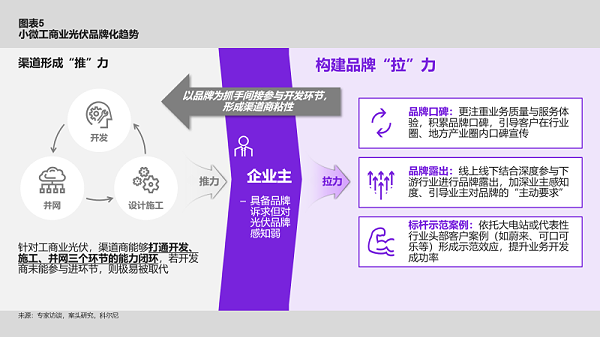
1、BIPV市场均处于早期发展阶段,长期存在爆发潜力
光伏建筑一体化(BIPV)指将光伏产品集成并作为建筑组成部分,是目前光伏产品创新的重点方向。全球BIPV市场均处于早期发展阶段,2022年中国、美国、欧洲新增装机量总计约为1.4GW;但预计至2030年前,BIPV有望实现技术突破和规模化降本,从而迎来经济性拐点,因此长期而言市场存在爆发式增长潜力
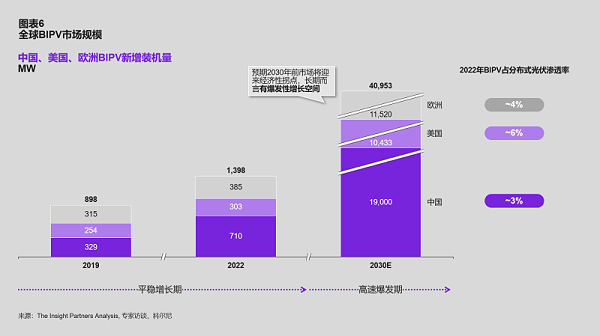
BIPV在欧美市场主要应用于私人及工商用户,而在当前中国市场的主要客群则是价格敏感度低、追求企业形象的大工商企业以及地标示范性行政公共建筑(如图表7)。目前国内BIPV渗透率偏低,主要源于整体分布式光伏新增装机量处于高位;未来随着产品TCO 效益凸显,工商用户接受度增加,以及国家及区域政府出具明确的BIPV 产品补贴政策,渗透率有望进一步提升。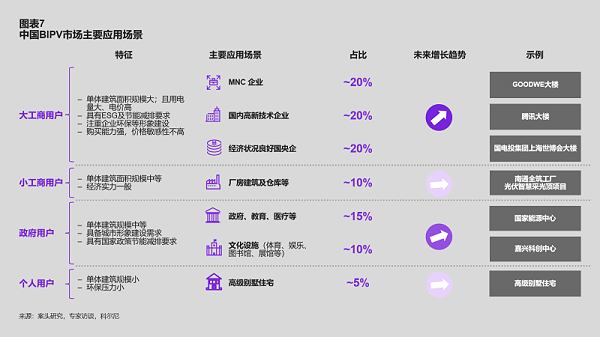
2、BIPV要跳出传统项目开发的思路与打法
由于BIPV“光伏+建筑”的双重属性,目前国内通常由光伏企业和建材企业合作开展BIPV项目,其中光伏企业承担更主要的责任:首先,光伏企业牵头产品研发,建材企业提供可供试验的建筑材料作为研发辅助,随后光伏企业主要负责BIPV产品的市场营销和品牌打造,双方企业分别利用自身销售渠道触达终端业主,其中建材企业可通过设计院影响业主的光伏产品采购选择
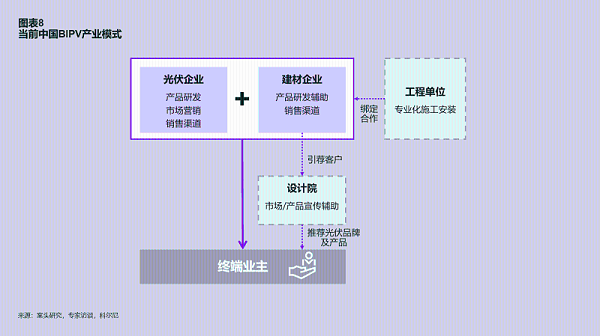
随着领先企业纷纷积极卡位BIPV赛道,科尔尼认为,未来以下三方面核心能力将成为在竞争中脱颖而出的制胜关键:
其一,产品与技术迭代能力。BIPV目前瓶颈主要在于尚未实现较好经济性,考虑其相比传统光伏产品存在一定技术壁垒、同质化尚不严重,因此通过技术迭代率先实现经济性的企业将具有巨大的领先优势,乃至较长的市场独占期。另外作为建筑材料,通过技术创新提升产品美观性也尤为重要,也是获得更多利润的根本;
其二,市场销售渠道布局能力。BIPV的市场拓展依赖于广泛的渠道网络以触达更多潜在终端业主。由于BIPV产品具有建材属性、需要满足建筑的定制化需求,利用建筑企业和设计院等渠道更早切入、在设计阶段尽早统筹考虑BIPV方案,对
BIPV 厂商开发客户也能够产生积极影响;
其三,专业化销售能力。传统光伏需要在现有屋顶上进行打孔、固定支架等二次施工,往往对厂房结构和防水性能等造成不利影响;而BIPV的核心价值就在于不破坏原有建筑物的结构和功能,具有防火、防水、美观等多重优势。在BIPV尚未实现经济性的情况下,更需要专业化的销售能力来实现客户教育,使客户认可和接受其核心价值主张。
Industrial and commercial photovoltaics refer to photovoltaic power generation projects deployed on the roofs and open spaces of industrial and commercial enterprises' factories and warehouses, with an installed capacity of 1MW as the boundary. Above
are large industrial and commercial photovoltaics, and below are small and micro industrial and commercial photovoltaics.
The high demand for energy in industry and commerce, as well as the large total roof area of factories, is an important scenario
for achieving the comprehensive development and utilization of photovoltaics and accelerating the transformation of green energy development. In 2022, driven by factors such as the rise in industrial electricity prices, dual control of energy consumption,
and the large-scale entry and holding of "five major and six small" power generation groups, the industrial and commercial photovoltaic market is experiencing an outbreak, accompanied by increasingly fierce market competition.
The photovoltaic industry
is a key industry in China's energy transformation strategy to achieve the "dual carbon" goal. In the past, the photovoltaic market mainly focused on the development of centralized large power stations and the construction of rural household photovoltaic
power stations held and led by the "five major and six small" power generation groups.
In 2022, the new installed capacity of industrial and commercial photovoltaics for grid connection increased explosively from 8GW in 2021 to 25GW in 2022 (if considering
the shutdown during the peak period of grid connection caused by the pandemic in December, the actual market potential is close to 30GW). The main driving factors include the increase in electricity price costs, the impact of energy consumption dual control,
the enhancement of owner installation awareness, and the entry of third-party capital. The main scenario for current industrial and commercial photovoltaics is in large industrial and commercial enterprises with more stable business continuity and lower
asset risk.
Looking ahead, small and micro businesses are expected to break through inflection points and become new growth engines in the market within 2-3 years; The medium to long-term market demand will shift structurally towards BIPV, driving
a significant increase in industry value and profit levels
The participants in the industrial and commercial photovoltaic power plant market mainly include four types: owners, developers, owners, and engineering parties, each assuming different roles:
the owner is the user of the factory building and the user of electricity (except for full grid access); The developer serves as a bridge between the owner, capital, and engineering parties, and there is a common intersection with the owner and engineering
parties; The holding party is the actual holding unit of the power station assets, which can obtain power generation income; The engineering party is the actual construction unit of the photovoltaic power station, which includes two types: pure engineering
team and EPC general contracting unit.
Large industrial and commercial photovoltaics refer to photovoltaic power plant projects with a single project power generation scale of over 1MW. Driven by the dual drive of large-scale entry and ownership
by power generation groups and increased willingness of owners to install, their annual installed capacity has surged from 6GW in 2021 to 19GW in 2022, becoming the main driving force for the outbreak of industrial and commercial photovoltaics in 2022.
Corps-Nuds believes that there is still room for growth in the installed capacity of large industrial and commercial PV in the next 2-3 years. In the medium and long term, as the installed capacity tends to be saturated and the BIPV penetration rate of
new buildings increases, the traditional PV installed capacity of large industrial and commercial PV will gradually fall back.
Da Gong Commercial Photovoltaics can be divided into four major models based on the different holders of power station
assets. Overall, the holding model of the "five major and six small" power generation groups occupies a dominant position in the market. However, as the economy and safety of photovoltaics gradually undergo market tests, the proportion of owner owned
and local capital holding models will continue to rise in the future.
1. Owners' self-sufficiency model: Industrial and commercial owners independently invest and hold power plant assets, which can obtain the highest theoretical returns. From the
perspective of the power station construction party, a small portion is self built by the owner, while most businesses